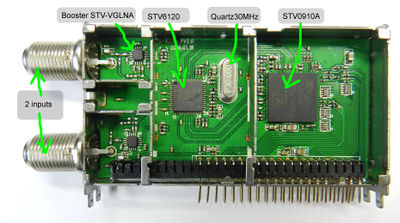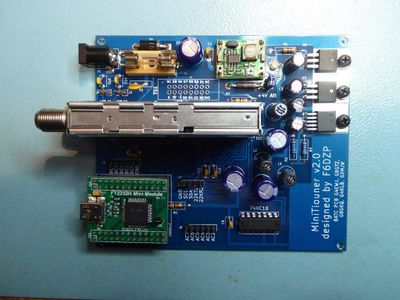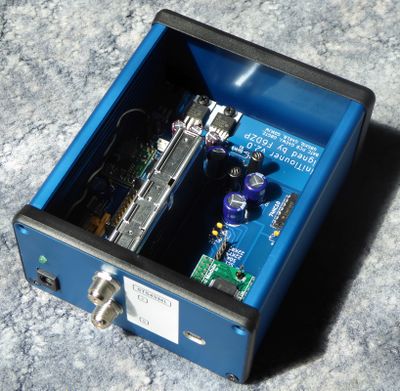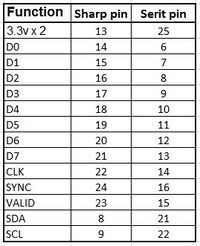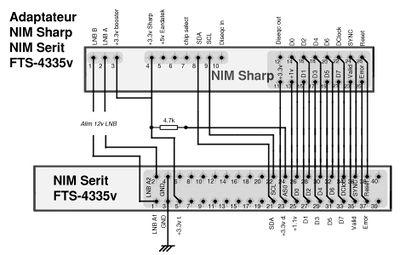Difference between revisions of "Serit tuner"
| (12 intermediate revisions by 4 users not shown) | |||
| Line 1: | Line 1: | ||
| − | As of February 2017 the Sharp and Samsung NIMs are no longer available and the MiniTiouner project will use a NIM from Serit | + | As of February 2017 the Sharp and Samsung NIMs are no longer available and the MiniTiouner project will use a NIM (or tuner) from Serit which covers from 143.75MHz right through to 2450 MHz without the need for any upconverters. |
The first prototype was shown at CAT16 by Jean-Pierre F6DZP - you can watch a video of his presentation on the [https://www.youtube.com/watch?v=qMSwRDpAsc0&index=5&list=PLhLAVxsCvzNCug95lETI5ZcwtK1AkWvi8 BATC Youtube channel]. | The first prototype was shown at CAT16 by Jean-Pierre F6DZP - you can watch a video of his presentation on the [https://www.youtube.com/watch?v=qMSwRDpAsc0&index=5&list=PLhLAVxsCvzNCug95lETI5ZcwtK1AkWvi8 BATC Youtube channel]. | ||
| Line 17: | Line 17: | ||
Just to confuse the issue there are now 2 versions of the Serit NIM! Both types work with the new Version 2 MiniTiouner PCB and adapter card for the Version 1 PCB. | Just to confuse the issue there are now 2 versions of the Serit NIM! Both types work with the new Version 2 MiniTiouner PCB and adapter card for the Version 1 PCB. | ||
| − | The only difference between the FTS- | + | The only difference between the FTS-4335V, which was sold in the BATC shop before before April 2017, and the FTS-4334L sold after May 2017 is the addition of an internal amplifier or booster stage before the demodulator chip. |
| + | |||
| + | The pinout of both tuners is the same and they are interchangeable in the MiniTiouner PCB. | ||
The units can be identified by the model number, which is printed on the opposite end of the unit to the F type connectors. | The units can be identified by the model number, which is printed on the opposite end of the unit to the F type connectors. | ||
| − | ====Serit FTS- | + | ====Serit FTS-4335V (sold before April 2017)==== |
[[File:FTS4335Vopen_Eng.jpg|400px]] | [[File:FTS4335Vopen_Eng.jpg|400px]] | ||
| Line 27: | Line 29: | ||
To overcome the lack of the booster, an additional satellite line amp can be used in front of the tuner. | To overcome the lack of the booster, an additional satellite line amp can be used in front of the tuner. | ||
| − | ====Serit | + | Data sheet of Serit 4335 NIM [[:File:FTS-4335 Series_F2.pdf]] |
| + | |||
| + | ====Serit FTS4334L (sold after May 2017)==== | ||
| + | |||
| + | [[File:FTS4334LVopen_Eng.jpg|400px]] | ||
| + | |||
| + | The FTS-4334L unit has a built in booster and will not require an external line amplifier. | ||
| + | |||
| + | Datasheet of Serit 4334L NIM [[:File:FTS-4334L Series_F1.pdf]] | ||
| + | |||
| + | ====Repairing the Serit DC output==== | ||
| + | |||
| + | It is very easy to blow up the RF choke feeding DC to the F type inputs before connecting to a dummy load or short circuit antenna - or by just shorting the centre pin to ground. The result is DC on the connector on the main board but no DC on the F type center. | ||
| − | + | Each F type is fed by a seperate RFC which looks like a ceramic capacitor and is shown in the picture below. These can be replaced with care with a normal leaded RFC or SMD RFC. | |
| − | + | [[File:serit rfc.JPG|400px]] | |
===MiniTiouner Version 2 main board=== | ===MiniTiouner Version 2 main board=== | ||
The Serit tuner has a different pin out to the original Sharp unit and as of April 2017 a version 2 main PCB has been designed to directly take the Serit tuner - [[MiniTiouner hardware Version 2|see this page for details]] -any new constructors should use this version 2 new board. | The Serit tuner has a different pin out to the original Sharp unit and as of April 2017 a version 2 main PCB has been designed to directly take the Serit tuner - [[MiniTiouner hardware Version 2|see this page for details]] -any new constructors should use this version 2 new board. | ||
| + | |||
| + | Note the A input is the upper connector (furthest from the PCB). The B input is the lower one, closest to the PCB. | ||
| + | |||
| + | [[File:Serit complete.jpg|400px]] [[File:Low_Noise_Serit.jpg|400px]] | ||
===Serit adapter card=== | ===Serit adapter card=== | ||
| Line 71: | Line 89: | ||
The Serit NIMs are capable of receiving more than one signal simultaneously; however the BATC hardware and software can only receive one signal at a time. There is provision for a socket on the converter PCB to connect to the second receive output of the NIM for experimentation. F6DZP's dual receive software is still under development and may be available for testing. See his web site at: http://www.vivadatv.org | The Serit NIMs are capable of receiving more than one signal simultaneously; however the BATC hardware and software can only receive one signal at a time. There is provision for a socket on the converter PCB to connect to the second receive output of the NIM for experimentation. F6DZP's dual receive software is still under development and may be available for testing. See his web site at: http://www.vivadatv.org | ||
| − | |||
| − | |||
| − | |||
| − | |||
| − | |||
| − | |||
| − | |||
| − | |||
| − | |||
| − | |||
Latest revision as of 17:50, 16 May 2019
As of February 2017 the Sharp and Samsung NIMs are no longer available and the MiniTiouner project will use a NIM (or tuner) from Serit which covers from 143.75MHz right through to 2450 MHz without the need for any upconverters.
The first prototype was shown at CAT16 by Jean-Pierre F6DZP - you can watch a video of his presentation on the BATC Youtube channel.
Why should I buy a Serit tuner?
- You should buy one if you already have MiniTiouner hardware and you want to be able to receive 146 MHz and 70cms without building an upconverter.
- You should buy one if you already have MiniTiouner hardware and want to experiment with the higher DVB-S2 modes such as 32APSK which the Sharp NIM cannot demodulate.
- You should buy one if you have not yet built a MiniTiouner receiver as the previous Sharp tuner is no longer available.
If none of the above apply, you don't need one!
2 versions of the Serit NIM!
Just to confuse the issue there are now 2 versions of the Serit NIM! Both types work with the new Version 2 MiniTiouner PCB and adapter card for the Version 1 PCB.
The only difference between the FTS-4335V, which was sold in the BATC shop before before April 2017, and the FTS-4334L sold after May 2017 is the addition of an internal amplifier or booster stage before the demodulator chip.
The pinout of both tuners is the same and they are interchangeable in the MiniTiouner PCB.
The units can be identified by the model number, which is printed on the opposite end of the unit to the F type connectors.
Serit FTS-4335V (sold before April 2017)
To overcome the lack of the booster, an additional satellite line amp can be used in front of the tuner.
Data sheet of Serit 4335 NIM File:FTS-4335 Series_F2.pdf
Serit FTS4334L (sold after May 2017)
The FTS-4334L unit has a built in booster and will not require an external line amplifier.
Datasheet of Serit 4334L NIM File:FTS-4334L Series_F1.pdf
Repairing the Serit DC output
It is very easy to blow up the RF choke feeding DC to the F type inputs before connecting to a dummy load or short circuit antenna - or by just shorting the centre pin to ground. The result is DC on the connector on the main board but no DC on the F type center.
Each F type is fed by a seperate RFC which looks like a ceramic capacitor and is shown in the picture below. These can be replaced with care with a normal leaded RFC or SMD RFC.
MiniTiouner Version 2 main board
The Serit tuner has a different pin out to the original Sharp unit and as of April 2017 a version 2 main PCB has been designed to directly take the Serit tuner - see this page for details -any new constructors should use this version 2 new board.
Note the A input is the upper connector (furthest from the PCB). The B input is the lower one, closest to the PCB.
Serit adapter card
The Serit tuner has a different pin out to the original Sharp unit and Brian G4EWJ has designed a PCB to enable it to be plugged in to the original Version 1 MiniTiouner PCB.
You only require the adaptor PCB if you are upgrading a MiniTiouner version 1 hardware to use the Serit tuner.
The adapter card build instructions, Parts List, Schematic and silkscreen print are in this zip file. NOTE - the kit referred to in the documentation is no longer available:
Software
To use either Serit NIM with the MiniTiouner, you will need to run Ver 0.6d or later versions of the excellent MiniTioune software. This is available for download from the Viva DATV forum here and will work with Sharp, Eardatek or Serit NIMs. You need to register on the Viva DATV forum before being able to download.
MiniTiouner version 6 or later also allows you to select which of the two antenna sockets is used on the Serit NIM, allowing one of two antennas / converters to be connected.
NIM pinouts
If, rather than use the adapter PCB, you want to attempt to hardwire the Serit tuner in to the version 1 PCB (why?), the pin differences between Sharp and Serit are as follows:
This picture from the http://www.vivadatv.org/ site shows the interconnection:
Filters and pre-amps
The wide band coverage makes building a receiver for 146 or 437 much easier, although you will need a pre-amp followed by lots of filtering for each band, just like the Sharp did.
Filter designs are available here
Dual receiver
The Serit NIMs are capable of receiving more than one signal simultaneously; however the BATC hardware and software can only receive one signal at a time. There is provision for a socket on the converter PCB to connect to the second receive output of the NIM for experimentation. F6DZP's dual receive software is still under development and may be available for testing. See his web site at: http://www.vivadatv.org

